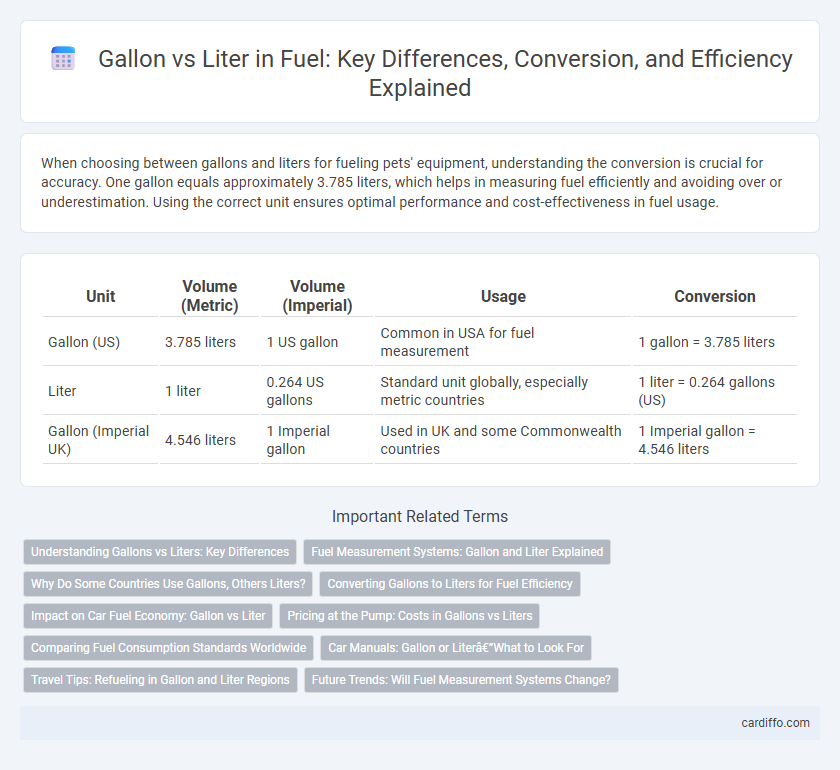When choosing between gallons and liters for fueling pets' equipment, understanding the conversion is crucial for accuracy. One gallon equals approximately 3.785 liters, which helps in measuring fuel efficiently and avoiding over or underestimation. Using the correct unit ensures optimal performance and cost-effectiveness in fuel usage.
Table of Comparison
| Unit | Volume (Metric) | Volume (Imperial) | Usage | Conversion |
|---|---|---|---|---|
| Gallon (US) | 3.785 liters | 1 US gallon | Common in USA for fuel measurement | 1 gallon = 3.785 liters |
| Liter | 1 liter | 0.264 US gallons | Standard unit globally, especially metric countries | 1 liter = 0.264 gallons (US) |
| Gallon (Imperial UK) | 4.546 liters | 1 Imperial gallon | Used in UK and some Commonwealth countries | 1 Imperial gallon = 4.546 liters |
Understanding Gallons vs Liters: Key Differences
Gallons and liters are units of volume commonly used to measure fuel, with one gallon equivalent to approximately 3.785 liters in the US measurement system. While gallons are primarily used in the United States, Liberia, and Myanmar, most other countries rely on liters for fuel measurement. Understanding the conversion between gallons and liters is essential for accurate fuel calculations, pricing, and consumption comparisons across different regions.
Fuel Measurement Systems: Gallon and Liter Explained
Fuel measurement systems primarily use gallons in the United States and liters in most other countries, reflecting imperial and metric systems respectively. One US gallon equals approximately 3.785 liters, making conversion critical for international fuel transactions and vehicle specifications. Understanding these units enhances accuracy in fuel efficiency calculations and cost comparisons across global markets.
Why Do Some Countries Use Gallons, Others Liters?
Countries using gallons for fuel measurement often follow the imperial or US customary systems, reflecting historical ties to the British Empire or American influence. Liter usage aligns with the metric system, widely adopted for its simplicity and global standardization in scientific and commercial contexts. The difference stems from historical legacies and international standard preferences influencing trade, manufacturing, and regulatory practices.
Converting Gallons to Liters for Fuel Efficiency
One gallon equals approximately 3.78541 liters, making it essential to convert gallons to liters accurately when comparing fuel efficiency metrics internationally. Fuel efficiency ratings often use miles per gallon (MPG) in the United States and liters per 100 kilometers (L/100km) in many other countries, requiring conversions for consistent analysis. Properly converting gallons to liters ensures precise calculations in fuel consumption, cost estimation, and environmental impact assessments.
Impact on Car Fuel Economy: Gallon vs Liter
Fuel economy measured in miles per gallon (mpg) versus kilometers per liter (km/L) reflects different regional standards but also impacts driver perception of efficiency. A gallon, predominantly used in the United States, holds approximately 3.785 liters, making direct comparisons essential for accurate fuel cost and consumption analysis across markets. Understanding these units improves decision-making about fuel usage, emissions, and overall vehicle efficiency in diverse driving conditions.
Pricing at the Pump: Costs in Gallons vs Liters
Fuel pricing at the pump varies significantly between gallons and liters due to regional measurement standards; in the United States, prices are commonly displayed per gallon, which is approximately 3.785 liters, often resulting in higher absolute numbers compared to per liter pricing used in most other countries. When comparing costs, a price of $3.60 per gallon translates to roughly $0.95 per liter, highlighting the importance of unit conversion for accurate price comparisons in international markets. Consumers should consider fuel efficiency and consumption rates expressed in liters per 100 kilometers or miles per gallon to effectively evaluate real fuel expenses.
Comparing Fuel Consumption Standards Worldwide
Fuel consumption standards vary significantly worldwide, with gallons commonly used in the United States while liters dominate in most other countries. One gallon equals approximately 3.785 liters, which makes international comparisons of fuel efficiency reliant on accurate unit conversions. Understanding these measurement differences is essential for evaluating vehicle performance and regulatory compliance across global markets.
Car Manuals: Gallon or Liter—What to Look For
Car manuals often specify fuel volume in either gallons or liters depending on the regional standard, with the United States primarily using gallons and most other countries using liters. Understanding whether your car manual lists fuel capacity in gallons or liters is crucial for accurate refueling and maintenance. Always cross-reference the fuel volume with your local gas station measurements to avoid errors in fuel purchases and vehicle performance.
Travel Tips: Refueling in Gallon and Liter Regions
Travelers should understand that fuel quantities are measured in gallons primarily in the United States, while liters are standard in most other countries worldwide. When refueling in gallon regions, expect a higher numerical value for fuel volume due to the smaller size of a gallon compared to a liter, with 1 gallon equaling approximately 3.785 liters. Staying aware of these differences helps optimize budget planning and accurately assess fuel consumption during international road trips.
Future Trends: Will Fuel Measurement Systems Change?
Fuel measurement systems are increasingly leaning towards liters due to global standardization and environmental regulations promoting precise consumption tracking. Advanced digital metering technologies enable more accurate fuel usage data, supporting carbon emission reduction goals worldwide. Emerging trends suggest a gradual shift from gallons to liters in many countries to align with international trade and sustainability efforts.
gallon vs liter Infographic

 cardiffo.com
cardiffo.com